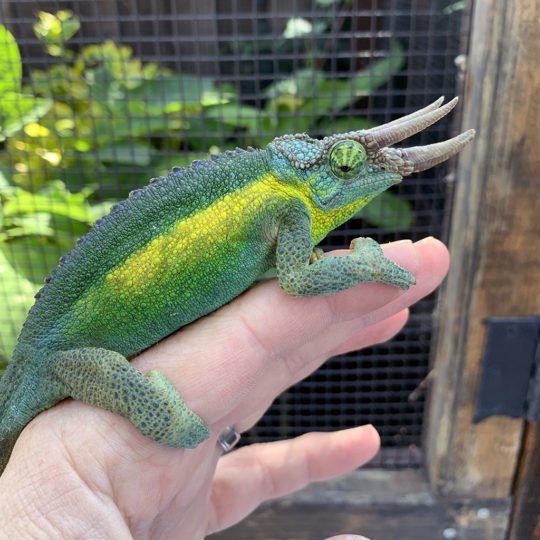
Just like a delicate flower can be both beautiful and tricky to care for, Jackson’s chameleons need a bit of know-how. Handling them is an important part of their care, but it’s not as straightforward as just picking them up. There’s an art to it, and knowing when to engage and when to give them space can make a world of difference in their health and happiness. So, grab a cup of coffee, and let’s dive in.
Understanding the Jackson’s Chameleon
Before we get into the nitty-gritty of handling, it’s helpful to understand what makes the Jackson’s chameleon so special. Native to the forests of East Africa, particularly Kenya and Tanzania, these reptiles are known for their ability to change color—much like mood rings, they can shift hues based on their environment and feelings. This color-changing ability is not just for show; it’s a form of communication, signaling everything from mood to temperature regulation.
You might be wondering how size factors into handling them. Adult Jackson’s chameleons generally measure between 10 to 15 inches long, making them a bit more substantial than some other chameleon species. With that size, they can be both delicate and robust at the same time. You need to be gentle but confident when handling them, ensuring they feel secure.
Handling a Jackson’s chameleon can be a rewarding experience, but it can also be challenging. They can be skittish creatures and stress easily, so understanding their body language is essential. If a chameleon is puffing up, changing colors rapidly, or hiding, these are all signs that it may need some space. Remember, you’re dealing with a creature that’s evolved to be cautious in the wild!
Do’s of Handling Jackson’s Chameleons
1. Do Create a Comfortable Environment
Before you even think about picking up your Jackson’s chameleon, ensure that it’s in a calm and safe environment. This means having a well-set-up habitat with proper humidity, heat, and hiding places. A comfortable chameleon is more likely to be receptive to handling.
Consider the temperature range in your chameleon’s enclosure. Having basking spots and cooler areas will help your pet regulate its body temperature. Remember, a happy chameleon is more likely to tolerate handling and less likely to show signs of stress.
2. Do Approach Slowly
When it’s time to handle your chameleon, think slow and steady. Jackson’s chameleons can be quite anxious, so sudden movements might send them into a panic. Instead, approach their habitat gently and move slowly, speaking softly to help soothe them.
You might want to use your hand as a perch rather than trying to grab them. This way, they can explore you at their own pace, which can build trust. Think of it like introducing a new friend to your circle—give them time to feel comfortable!
3. Do Handle with Care
While Jackson’s chameleons are sturdy little creatures, they can also be sensitive. Always use both hands to support your chameleon fully. This not only helps prevent drops or falls but also lets them feel secure.
It’s best to minimize handling sessions to short bursts, especially at first. Frequent, gentle handling can help them get used to you. Aim for a few minutes at a time, gradually increasing as they become more comfortable.
Don’ts of Handling Jackson’s Chameleons
1. Don’t Overhandle
The chameleon’s stress levels can spike if you handle them too often or for too long. Just like we need our alone time, they do too. If you notice your chameleon becoming restless or displaying defensive behaviors, it’s a sign to back off.
Instead of daily handling, try to stick to a couple of times a week. This way, they’ll associate your presence with safety rather than stress, making for a happier pet.
2. Don’t Use Force
It’s crucial to let your Jackson’s chameleon come to you rather than forcing interaction. If they’re showing signs of distress—like a puffed-up body, hiding, or trying to escape—it’s time to let them be. Forcing them can lead to injury and more stress for the animal.
Think of it like a cat: the more you chase after them, the faster they run away! Respect their space and allow them to engage on their own terms.
3. Don’t Ignore Their Needs
A chameleon’s needs go beyond just handling. They require a specific diet, proper lighting, and regular misting to stay hydrated. Ignoring these needs can lead to health issues, making handling more challenging, and potentially harmful for your chameleon in the long run.
Make sure you’re offering a balanced diet of insects and greens, and ensure they have access to UVB light for vitamin D synthesis. A well-cared-for chameleon will be happier, more interactive, and more approachable.
Recognizing Stress and Discomfort
Understanding your chameleon’s body language can be your best tool in handling them effectively. Stress signs include darkening colors, a puffed-up body posture, and rapid movements toward hiding spots. Recognizing these signs is crucial for ensuring their well-being.
If your chameleon is displaying stress, consider creating a quieter environment. You might want to lower the lights or reduce noise around their habitat. Sometimes, it’s just about giving them a little space to calm down.
Also, pay attention to how often they are shedding. A stressed chameleon may shed less often, which can impact its skin health. Regular shedding is a sign they are comfortable and healthy, allowing for smoother handling sessions in the future.
Building Trust with Your Chameleon
Building trust takes time but is entirely worth it. Start by simply sitting near their enclosure so they get used to your presence. Over days or weeks, try to get your chameleon accustomed to you and your voice. This slow exposure creates a sense of safety for them.
Once they seem comfortable with your presence, you can begin offering small, tasty treats from your hand. Mealworms or small crickets can entice them to come closer and build that trust. It’s all about positive reinforcement here—just like training a puppy!
Eventually, with patience, your chameleon may even come to you when you approach the enclosure. This is a sign you’ve built a solid bond, and it makes handling much more enjoyable for both of you.
Handling a Jackson’s chameleon can be a rewarding experience, but it’s all about patience, understanding, and respect for their unique needs. By following these do’s and don’ts, you’re on your way to creating a safe and loving environment for your scaly friend.
Remember, every chameleon is different, so take the time to learn what makes yours tick. With a little love and attention, you’ll foster a bond that brings joy to both you and your green companion. Happy chameleon handling!

